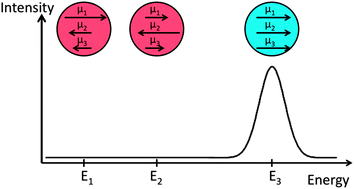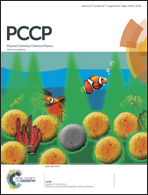Plasmon resonance analysis with configuration interaction†
Abstract
Dipole plasmon resonances are described quantum mechanically using configuration interaction (CI). A fictitious system of three interacting configurations is considered, which yields three excited states. Excited states energies and oscillator strengths are derived from the eigenvalues and eigenvectors of the CI matrix, where the diagonal elements αi (i = 1, 2, 3) correspond to the interacting one-electron transition energies and the off-diagonal elements βij correspond to the coupling between these configurations. The plasmonic state is easily identified by its higher energy and much larger oscillator strength. This high oscillator strength is due to a constructive addition of the eigenvectors contributing to this state. The maximum oscillator strength enhancement of the plasmon peak is equal to the number of configurations in the CI matrix (three here), which occurs in the ideal case where all α elements are equal and all β elements are equal. When the transitions involved in the CI have different energies (different α values), the oscillator strength of the plasmon peak becomes smaller and its energy is shifted in comparison to the ideal case. Increasing all the coupling values from 0 up to the point where the coupling is similar in magnitude to the difference in α values leads to a rapid rise of the plasmon peak oscillator strength whereas its energy slightly blue-shifts. A further increase of the coupling values does not affect the oscillator strength of the plasmon peak, which remains near its maximum enhancement value, but drastically affects its energy, which rapidly rises. The plasmonic behavior of noble metal model systems is successfully described using configuration interaction.


 Please wait while we load your content...
Please wait while we load your content...